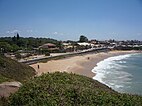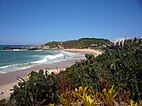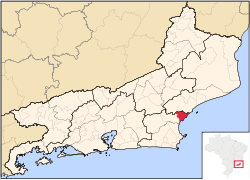This article has multiple issues. Please help improve it or discuss these issues on the talk page. (Learn how and when to remove these messages)
|
| Rio das Ostras | |
|---|---|
| Municipality | |
| Municipality of Rio das Ostras | |
      | |
 Flag Flag Seal Seal | |
 Location in Rio de Janeiro Location in Rio de Janeiro | |
| Coordinates: 22°31′37″S 41°56′42″W / 22.52694°S 41.94500°W / -22.52694; -41.94500 | |
| Country | |
| Region | Southeast |
| State | |
| Government | |
| • Mayor | Marcelino Carlos Dias Borba (PV) |
| Area | |
| • Total | 228.044 km (88.048 sq mi) |
| Elevation | 4 m (13 ft) |
| Population | |
| • Total | 156,491 |
| • Density | 690/km (1,800/sq mi) |
| Time zone | UTC−3 (BRT) |
| HDI (2010) | 0.773 – high |
| Website | riodasostras |
Rio das Ostras (Portuguese pronunciation: [ˈʁi.u dɐz ˈostɾɐs]) is a municipality located in the Brazilian state of Rio de Janeiro. Its population is 156,491 (2022) and its area is 228 km².
The municipality has been suffering from environmental impacts on account of the pollution of beaches, rivers and lagoons due to a lack of basic sanitation and environmental degradation as a consequence of illegal occupations in areas of environmental protection (APAs) for the protection and conservation of biotic attributes (fauna and flora). The inland discharge of clandestine sewage from homes and businesses has been causing eutrophication in the ecosystem in an aggressive way.
The systemic corruption of the municipality began from its political-administrative emancipation on April 10, 1992, and destroyed much of Rio das Ostras and to date there is no basic sanitation model. The lack of potable water, sewage, public road paving, and public transportation are old and systemic problems for a municipality that received trillions in oil royalties.
Nowadays, much of the coastline of Rio das Ostras suffers from the advance of the sea, erosions, and uneven irregular constructions. In the urban area there is a significant increase in slums, violence, unemployment and social inequality. The lack of basic sanitation affects every municipality.
Even though Rio das Ostras is struggling in different instances, the city holds various public and private schools for primary and secondary education. Also, it is home to different higher education Universities, such as Universidade Federal Fluminense (UFF), Universidade Unigranrio, and Universidade Estácio de Sá.
See also
References
- ^ "Brazilian Institute of Geography and Statistics" (in Portuguese). 2017. Retrieved 27 March 2019.
2018 Area Total
- IBGE 2020
- "Archived copy" (PDF). United Nations Development Programme (UNDP). Archived from the original (PDF) on July 8, 2014. Retrieved August 1, 2013.
{{cite web}}: CS1 maint: archived copy as title (link)
| Capital: Rio de Janeiro | |||||||||||
| Mesoregion Baixadas |
|  | |||||||||
| Mesoregion Centro Fluminense |
| ||||||||||
| Mesoregion Metropolitana do Rio de Janeiro |
| ||||||||||
| Mesoregion Noroeste Fluminense |
| ||||||||||
| Mesoregion Norte Fluminense |
| ||||||||||
| Mesoregion Sul Fluminense |
| ||||||||||